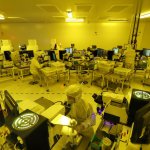Chip sales to grow at weakest pace since 2019, WSTS predicts

- The semiconductor firm said that in 2023, it sees chip sales rising just 4.6%, the weakest pace since 2019.
- The market is still expected to surpass US$600 billion this year.
- The most growth is expected from the Americas region at 23.5%, followed by Japan at 14.2%, Europe at 14%, and the largest region, Asia Pacific, is expected to grow by just 10.5%.
When the Semiconductor Industry Association (SIA) released the latest statistics on global chip sales earlier this month, the data showed growth decelerating for the sixth consecutive month. The ongoing slowdown is in fact the longest since the US-China trade war in 2018 — and it is a sign that the global economy, for the better part of this year, has been dragged down by the weight of rising interest rates and mounting geopolitical risks.
Now, in a separate forecast by World Semiconductor Trade Statistics (WSTS), a non-profit body that tracks shipments, even the market outlook for the year has been reduced to a 13.9% growth from a previous 16.3%. To top it off, in 2023, the semiconductor body sees chip sales rising just 4.6%, the weakest pace since 2019.
Although the market is still expected to surpass US$600 billion this year, WSTS said next year’s forecast growth would be the weakest since a 12% drop in sales at the height of the US-China trade war. “Following a strong growth year of 26.2% in the year 2021, WSTS expects another year of double-digit growth for the worldwide semiconductor market in 2022, with a forecast of US$633 billion, up 13.9%,” it said in a news release.
WSTS forecasts strong chip demand for another consecutive year, with most major categories expected to see high teens year-over-year (YoY) growth in 2022, led by logic with 24.1% growth, analog with 21.9% growth, and sensors with 16.6% growth. “Optoelectronics remains the weakest category in the forecast and is expected to be roughly flat (+0.2 percent) YoY,” it said.
In terms of regional growth, WSTS expets all geographical regions to show growth. Interestingly, the largest region, Asia Pacific, is expected to show the slowest growth from the rest in their list, at 10.5%. “The Americas are expected to show growth of 23.5%, Europe of 14%, and Japan of 14.2%,” the semiconductor body added, without noting exactly how they foresee chip demand to be in those regions.
As for next year, the global semiconductor market is projected to grow by 4.6% to US$662 billion, driven by mid-single digit growth in nearly all categories. In this latest round of forecasts by WSTS, the logic category is projected to reach US$200 billion in 2023, roughly 30% of the total market. Japan will probably see the strongest sales growth next year, at 5%, followed by the Americas at 4.8% and the Asia-Pacific region at 4.7%, according to WSTS.
Europe, where Russia’s war on Ukraine is reverberating across the continent’s economy, will likely post an expansion of just 3.2%. As it is, the International Monetary Fund last month downgraded its global growth forecast and said that 2023 may be tougher than this year. Generally, there are many analysts who believe that the semiconductor boom could be coming to an end, while others think the upcycle could continue despite some moderation in growth.
In a report earlier this month, S&P Global Ratings said the cycle looks set to turn for the booming global semiconductor market. “Given the capacity expansions in the recent upcycle and inventory stockpiling to avoid another round of Covid-related disruptions, downside risks abound. Our ratings leave headroom for cycle changes in cyclical sectors such as semiconductors. However, the coming cash crunch could be larger than usual,” it said.










